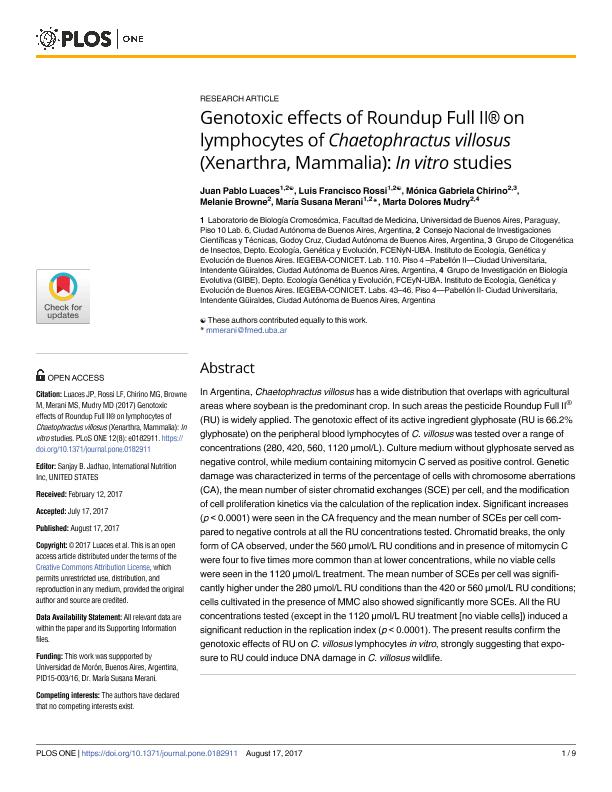Mostrar el registro sencillo del ítem
dc.contributor.author
Luaces, Juan Pablo

dc.contributor.author
Rossi, Luis Francisco

dc.contributor.author
Chirino, Monica Gabriela

dc.contributor.author
Browne, Melanie

dc.contributor.author
Merani, Maria Susana

dc.contributor.author
Mudry, Marta Dolores

dc.date.available
2018-11-27T12:23:09Z
dc.date.issued
2017-08
dc.identifier.citation
Luaces, Juan Pablo; Rossi, Luis Francisco; Chirino, Monica Gabriela; Browne, Melanie; Merani, Maria Susana; et al.; Genotoxic effects of Roundup Full II® on lymphocytes of Chaetophractus villosus (Xenarthra, Mammalia): In vitro studies; Public Library of Science; Plos One; 12; 8; 8-2017; 1-9; e0182911
dc.identifier.issn
1932-6203
dc.identifier.uri
http://hdl.handle.net/11336/65258
dc.description.abstract
In Argentina, Chaetophractus villosus has a wide distribution that overlaps with agricultural areas where soybean is the predominant crop. In such areas the pesticide Roundup Full II® (RU) is widely applied. The genotoxic effect of its active ingredient glyphosate (RU is 66.2% glyphosate) on the peripheral blood lymphocytes of C. villosus was tested over a range of concentrations (280, 420, 560, 1120 μmol/L). Culture medium without glyphosate served as negative control, while medium containing mitomycin C served as positive control. Genetic damage was characterized in terms of the percentage of cells with chromosome aberrations (CA), the mean number of sister chromatid exchanges (SCE) per cell, and the modification of cell proliferation kinetics via the calculation of the replication index. Significant increases (p < 0.0001) were seen in the CA frequency and the mean number of SCEs per cell compared to negative controls at all the RU concentrations tested. Chromatid breaks, the only form of CA observed, under the 560 μmol/L RU conditions and in presence of mitomycin C were four to five times more common than at lower concentrations, while no viable cells were seen in the 1120 μmol/L treatment. The mean number of SCEs per cell was significantly higher under the 280 μmol/L RU conditions than the 420 or 560 μmol/L RU conditions; cells cultivated in the presence of MMC also showed significantly more SCEs. All the RU concentrations tested (except in the 1120 μmol/L RU treatment [no viable cells]) induced a significant reduction in the replication index (p > 0.0001). The present results confirm the genotoxic effects of RU on C. villosus lymphocytes in vitro, strongly suggesting that exposure to RU could induce DNA damage in C. villosus wildlife.
dc.format
application/pdf
dc.language.iso
eng
dc.publisher
Public Library of Science

dc.rights
info:eu-repo/semantics/openAccess
dc.rights.uri
https://creativecommons.org/licenses/by-nc-sa/2.5/ar/
dc.subject
C. Villosus
dc.subject
Roundup
dc.subject
Genotoxicity
dc.subject
Chromosomal Aberrations
dc.subject
Sister Chromatid Exchange
dc.subject
Cell Proliferation Kinetics
dc.subject.classification
Otras Ciencias Biológicas

dc.subject.classification
Ciencias Biológicas

dc.subject.classification
CIENCIAS NATURALES Y EXACTAS

dc.title
Genotoxic effects of Roundup Full II® on lymphocytes of Chaetophractus villosus (Xenarthra, Mammalia): In vitro studies
dc.type
info:eu-repo/semantics/article
dc.type
info:ar-repo/semantics/artículo
dc.type
info:eu-repo/semantics/publishedVersion
dc.date.updated
2018-10-23T18:33:49Z
dc.journal.volume
12
dc.journal.number
8
dc.journal.pagination
1-9; e0182911
dc.journal.pais
Estados Unidos

dc.journal.ciudad
San Francisco
dc.description.fil
Fil: Luaces, Juan Pablo. Universidad de Buenos Aires. Facultad de Medicina. Laboratorio de Biología Cromosómica; Argentina. Consejo Nacional de Investigaciones Científicas y Técnicas; Argentina
dc.description.fil
Fil: Rossi, Luis Francisco. Universidad de Buenos Aires. Facultad de Medicina. Laboratorio de Biología Cromosómica; Argentina. Consejo Nacional de Investigaciones Científicas y Técnicas; Argentina
dc.description.fil
Fil: Chirino, Monica Gabriela. Consejo Nacional de Investigaciones Científicas y Técnicas. Oficina de Coordinación Administrativa Ciudad Universitaria. Instituto de Ecología, Genética y Evolución de Buenos Aires. Universidad de Buenos Aires. Facultad de Ciencias Exactas y Naturales. Instituto de Ecología, Genética y Evolución de Buenos Aires; Argentina
dc.description.fil
Fil: Browne, Melanie. Consejo Nacional de Investigaciones Científicas y Técnicas; Argentina
dc.description.fil
Fil: Merani, Maria Susana. Universidad de Buenos Aires. Facultad de Medicina. Laboratorio de Biología Cromosómica; Argentina. Consejo Nacional de Investigaciones Científicas y Técnicas; Argentina
dc.description.fil
Fil: Mudry, Marta Dolores. Consejo Nacional de Investigaciones Científicas y Técnicas. Oficina de Coordinación Administrativa Ciudad Universitaria. Instituto de Ecología, Genética y Evolución de Buenos Aires. Universidad de Buenos Aires. Facultad de Ciencias Exactas y Naturales. Instituto de Ecología, Genética y Evolución de Buenos Aires; Argentina
dc.journal.title
Plos One

dc.relation.alternativeid
info:eu-repo/semantics/altIdentifier/doi/http://dx.doi.org/10.1371/journal.pone.0182911
dc.relation.alternativeid
info:eu-repo/semantics/altIdentifier/url/https://journals.plos.org/plosone/article?id=10.1371/journal.pone.0182911
Archivos asociados
